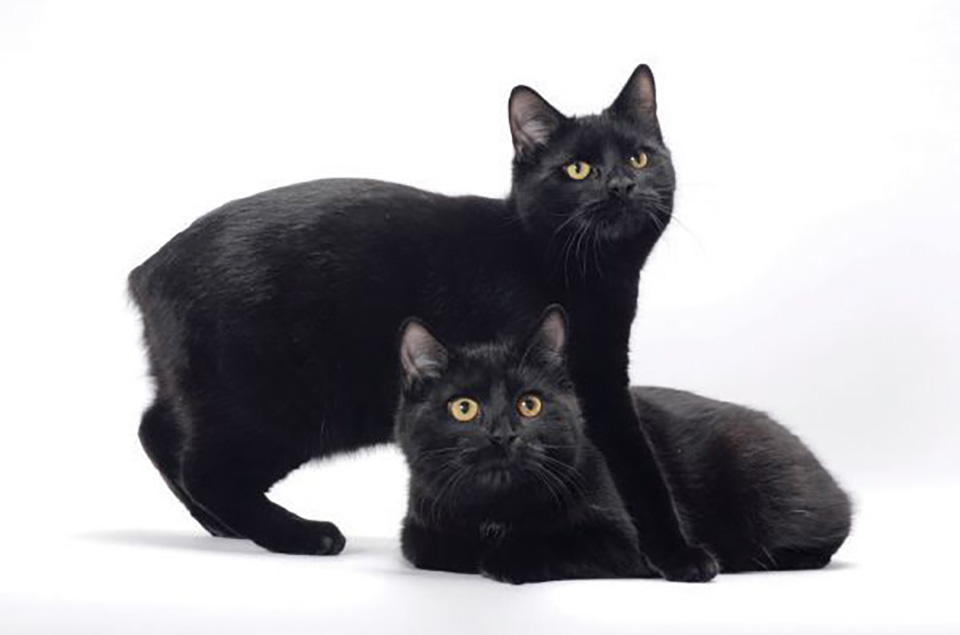
When I was a child, we acquired a small black cat, which someone, in a moment of sparkling imagination, had named “Blacky”. It was a Manx cat, an unusual and distinctive domestic breed that originated on the Isle of Man, a small island in the Irish Sea and best known for its round-the-island motor cycle races. Manx cats have a naturally occurring mutation that dramatically shortens the tail. Many of them have no tail at all, merely an apologetic stump where you’d expect a tail to be. Tail-less cats exist in a few other places notably Denmark and the Crimea, and their origin is invariably shrouded in local legend.
Black cats – with or without tails – have their own folklore and are surrounded by superstitions that date back centuries. In ancient Egypt in the fifth century BC, most cats were worshipped and to kill one of them was a serious crime punishable by death. During the 10th century, King Henry I of Saxony decreed that should anyone feel compelled to kill a black cat, they’d be fined fine sixty bushels of corn. That was something of a deterrent because a bushel weighs 56 pounds (25 Kg).
But later in the Middle Ages, the attitudes towards black cats had changed. They were avoided because of their supposed association with black magic and witches. Some people even believed that black cats were witches in disguise, with the result that in 14th century Europe, many black cats were destroyed. The unexpected outcome was a significant increase in the rat population, which almost certainly contributed to the spread of bubonic plague, better known by its more theatrical name, the Black Death. However, whether black cats are considered lucky or unlucky depends very much on where you live. In Britain and many parts of Asia, black cats are considered good omens. So too in Chile, origin of the well-known Gato Negro (GAH-toh NAY-groh) range of wines. And you don’t need advanced linguistic skills to realize that the name means “black cat” in Spanish.
Gato Negro wines are made by the Chilean winery Viña San Pedro, a company that can trace its origins back to 1865. In that year, the splendidly-named José Gregorio Correa Albano San Pedro and his brother Bonifacio acquired land in the Curicó Valley that was suitable for vineyards. They made their first wines with local grapes, but later used imported vines from France and Germany. Today, the company is one of the largest exporters of Chilean wine and produces a range of popular varietals several of which can be found in Thailand. San Pedro’s main vineyards and cellars are in the country town of Molina in the centre of Chile and a couple of hundred miles south of Santiago, the country’s capital. The Gato Negro range first appeared in the 1960s and they now sell more than forty-eight million bottles every year, a number sufficiently staggering to make my mind go blank without even drinking any of them.
Gato Negro Sauvignon Blanc 2020 (white), Chile (Bt. 499 @ Central & Tops)
I first tasted this wine about twelve years ago when the Gato Negro brand began to appear locally. Made from grapes grown in San Pedro’s Molina vineyards, the wine is an attractive pale gold with a forward and pleasing aroma of pineapple and tropical fruit. There are hints of herbs in the background and a hint of dill. Incidentally, in case you are new to wine, Sauvignon Blanc (SOH-vihn-yohn BLAHN) is a white-wine grape originally from the Bordeaux area of France and tends to be sharper and more acidic than Chardonnay. In France’s Loire Valley the grape makes crisp and mineral-tasting wines which are perfect for fish dishes or light salads. It’s also the sole grape in the Loire wine Pouilly-Fumé. Some people are put off Sauvignon Blanc because it can sometimes taste a bit tart, especially some from New Zealand.
But this Chilean Sauvignon wine is almost the polar opposite of its zesty cousins from France and New Zealand. It’s a light, low-acidity wine, quite soft and undemanding but plenty of rich dry fruit on the palate and a pleasant lingering aftertaste. Although it’s a pretty basic wine, I found it attractive and I’d be quite happy to enjoy on its own. The fruity taste and clean refreshing tang give it a lively character. At only 12.5 % alcohol, it’s a mild and unassuming easy-drinker which you could pair with light curries, salsas, vegetable dishes, quiches and creamy cheeses. Sauvignon Blanc is also one of the few wines that go well with sushi. And in case you’re wondering, the Gato Negro wine brand was named after a cat once owned by the company’s wine maker. You can probably guess the colour of the cat.
 |
 |
 |





